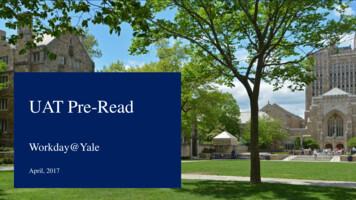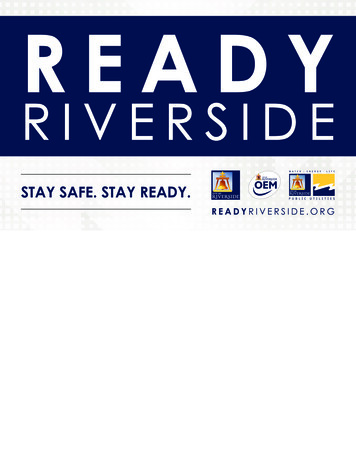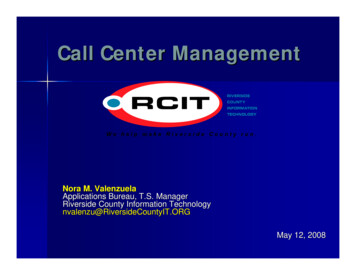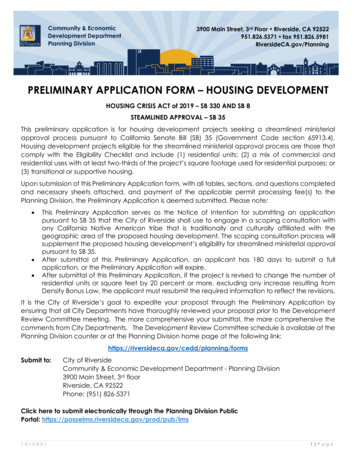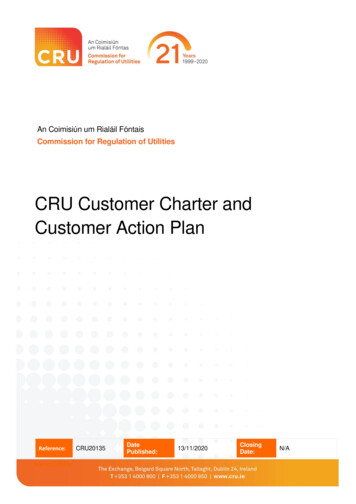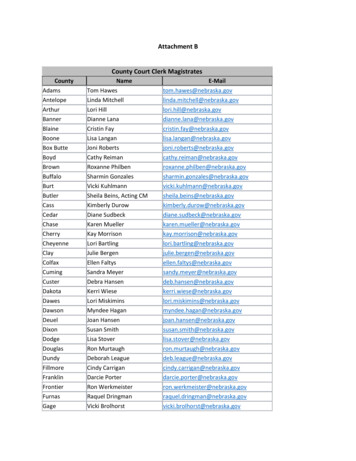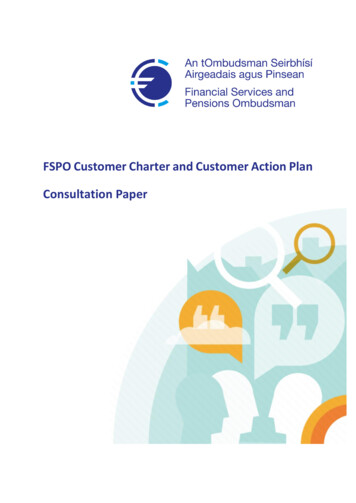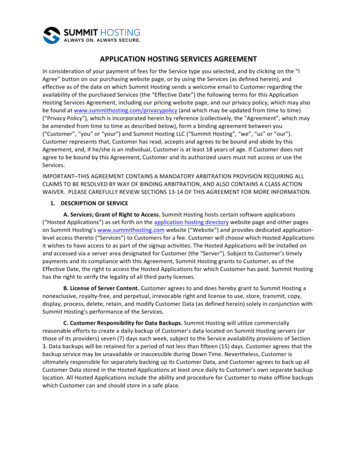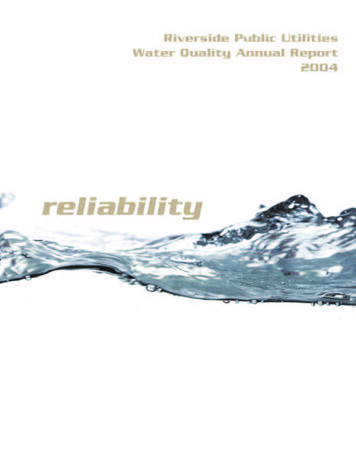
Transcription
Dear Riverside WaterCustomer,I am pleased to report that once again, our water metor exceeded all state and federal drinking water quality standards in 2004.The Board of Public Utilities and our entire staff worktogether to continuously provide safe and healthydrinking water at the lowest possible cost to Riversideresidents, businesses and visitors.This year’s 2004 Water Quality Annual Report features the many components it takes to makea reliable water delivery system - Riverside’s water supply, water system, water storage and water security.Riverside has invested millions and millions of dollarsover the past century to build our present water system.It may surprise you to learn that it would take nearly 1 BILLION to replace our water system at today’scost.Is it worth it?Considering the value of a reliable water system just interms of protecting our public health, assuring a highquality of life, providing fire protection, and promotingeconomic development, the answer is most definitely“YES!” The Board is developing a variety of programsand projects to ensure our water system remains sound.We welcome you to attend our Board of Public Utilitiesmeetings at Riverside City Hall at 8:15 a.m. on the firstand third Fridays of each month and our WaterCommittee meetings on the third Friday of each monthimmediately following the Board meeting.Sincerely,ReliabilityWhat makes a water system reliable?It requires much more than simply making sure water comes out when you turnon a faucet. System Reliability means: Delivering water with enoughpressure to quickly douse ablaze when a fire hydrant isopened Maintaining sufficient sourcesof water for present and futureneeds Building treatment plantsto filter out harmfulchemicals and to protectour water from biologicalcontamination Constructing emergency and operational waterstorage capacity in reservoirs Continuously testing and treatingyour water supply Finding ways to conserve andrecycle water to ensure adequatesupplies for future generations Planning ahead to anticipate future water needs Protecting water supplies from potential contamination Establishing rates sufficient to pay for currentoperations plus necessary repairs and improvementsto the systemDavid H. WrightRiverside Public Utilities Director Systematically replacing aging water mains toprevent major problems1
SupplyPreparing for the futureCaretakers of water resourcesPotable means water you can drink. There isgrowing competition regionally and locally for thelimited potable water resources available. At somepoint in the near future, we may need to increaseour use of imported water, which will be moreexpensive than local water sources.Most of our water (typically over 95%) comes fromwells in groundwater basins in San Bernardino andRiverside. In 2004, Riverside Public Utilities deliverednearly 83,490 acre-feet of water to our customersfrom all sources.The Utility is actively pursuing the newest treatmenttechnologies to enhance our ability to use local,non-potable underground water supplies. Plans arealso underway to use recycled, tertiary treatedwater from our wastewater plant to replacepotable water used for irrigation.To minimize the need to buy more high-pricedwater, we also plan to increase available waterfrom various water conservation measures overthe next few years. We are counting on Riversideresidents and businesses to Be Waterwise and useless water indoors and especially outdoors. Halfthe water used by single family homes is for outdoor watering. And most southern Californiansuse double the water needed to keep plantshealthy.By working together to Be Waterwise, Riversidecan conserve our underground water supplies thatwe depend on andlower the amount ofhigh-priced state waterwe import.We have an obligation tobe caretakers of our waterresources now and for thegenerations who follow.As caretakers of our limitedwatersupplies,Riverside Public Utilities: Works in coordination with other local waterutilities and agencies to actively track howmuch pumping the groundwater basins cansustain to avoid using more water than isput back in the basins each year Regularly tests our wells and tracks plumes ofcontaminants so we can anticipate and dealwith potential problems Works to eliminate the use of septic tanks thatcould pollute groundwater basins Manages chlorination stations to inactivateharmful bacteria and viruses Operates granular activated carbon treatmentplants to remove organic elements includingpesticides, herbicides, fertilizers, fuel byproducts and cleaning solvents, and ionexchange plants to remove perchlorate2
SystemInvesting in a reliable water system for our futureWater main replacement projectRiverside is a beautiful, historic community. Butthere’s nothing beautiful about aging water mains- some between 50 to 75 years old. The WaterMain Replacement Project is an on-going programto replace five miles of older, failing pipelines peryear. The 25 miles of new, larger water mainsinstalled over the last five years improve fire fighting capabilities, increase water pressure, delivermore water, and avoid potential flood damage tohomes, businesses and streets.Riverside Canal rehabilitationAfter 134 years of service, the Riverside Canal,that stretches 12 miles from Colton to JeffersonStreet near the Riverside Auto Center has beenrehabilitated. The City of Riverside received a 5.25 million grant from the California WaterResources Control Board (CWRCB) towardsits 8.5 million rehabilitation. It’s now readyfor another century of dependable irrigationwater delivery.Protecting Riverside’s water from perchlorateTreating for perchlorate has been a focus for several years. In March 2004, California EPA adopteda public health goal of 6 parts per billion (ppb) andthe California Department of Health Services adopted an Action Level of 6 ppb for perchlorate.When perchlorate was first detected in some ofRiverside’s wells, federal and state regulators hadno set standard. But, Riverside Public Utilitiestook action then to protect your water supply. Weinstalled four state-of-the-art, ion-exchange treatment plants by 2004 with one more to be installedin 2005.Riverside continues to develop treatment optionsto meet changing water quality regulations.Through treatment, Riverside has reduced perchlorate levels annually.Riverside’s Yearly AveragePerchlorate Level2002 – 4.6 ppb2003 – 2.3 ppb2004 – 1.7 ppb3
StorageEmergency reserves and readinessPiedmont ReservoirRiverside Public Utilities is proactive when itcomes to emergency water storage facilities andpipeline protection.We have 16 reservoirs in town with a combinedcapacity of over 100 million gallons. This shouldbe enough, in the event of an emergency, to provide residents with three to five days of water.Stewart IntakeReservoirSeveral additional reservoirs to increase emergency water storage to an even greater level arepart of our long-range facilities plan.In addition, we have emergency connections withother utilities should a major water supply sourcebe interrupted.Drinking Water.Riverside and most public water systems havesafely used chlorine and/or chloramines (a combination of chlorine and ammonia) to disinfectpotentially harmful bacteria that may enter drinking water. Chlorine disinfection of water supplieshas been hailed as one of the greatest inventionsof the 20th Century. It has been instrumental incontrolling many potential waterborne diseases,such as cholera, diphtheria, and dysentery.Drinking water treated with chlorine or chloramines is safe for everyone to use for drinking,bathing, cooking and all other daily uses. Thisincludes: pregnant women, children and infants,people on kidney dialysis, people on low-sodiumdiets, people with diabetes and pets.4Chlorine and chloramines must be removed fromthe water used in kidney dialysis machines.Although it is safe for dialysis patients to drinkwater with chlorine and chloramines, it is not safeto have it directly enter their bloodstream.Water for fish - after special treatmentChlorine and chloramines are both toxic to fish.Before using drinking water in a fish tank, aquarium or pond, it should first be treated to removeBOTH chloramines and chlorine. Contact your local petsupply store for the bestmethods to remove bothchlorine and chloramines.
SecurityA reliable water system is thebackbone of fire protectionAmong Water Division priorities, protecting livesand property from fire is second only to providingclean water to sustain life.Fully one third of all funds the Water Divisionspends on capital improvements is related to providing adequate fire protection for the people,homes and businesses of Riverside. That involves39 booster stations to ensure sufficient water supply and water pressure reaches all neighborhoods; 16 reservoirs to store emergency suppliesof water in case of disaster, and replacement ofmiles of aging 4-inch water main each year withnew, 8-inch water mains. The larger water mainsdeliver four times more water and increase waterpressure.Protecting the water system thatprotects the communitySeveral levels of security are employed to protectour water supply. In addition to security patrols,a Supervisory Control and Data Acquisition(SCADA) System enables staff to remotely monitorand control our production, treatment, and distribution facilities.Other security measures are being added as aresult of a Water System Security VulnerabilityAssessment, such as remote video systems, additional fencing, and real-time remote monitoring ofwater quality throughout the system.5
Riverside Public Utilities 2004 Water Quality ReportPrimary Standards: Mandatory Health-Related StandardsPercent system source - Groundwater 95%AVERAGERANGEMicrobiologicalTotal Coliform (P/A) (a) - - - - - - - - - - - 5%0%0%0 - 1.1%Naturally presentin environmentClarityTurbidity- - - - - - - - - - - - - - - - - - - - - - - - 0.5 NTUNS0.1 NTU0 - 0.4 NTUNaturally presentin environmentRegulated OrganicTotal Trihalomethanes - - - - - - - - - - - - - 80 ppb“TTHMs”NS7 ppbND - 54 ppbBy-product of drinkingwater chlorinationHalocetic Acids “HAA5” - - - - - - - - - - 60 ppbNS1.0 ppbND - 10.0 ppbBy-product of drinkingwater chlorinationChlorine- - - - - - - - - - - - - - - - - - - - - - - - 4 ppm4 ppm0.6 ppm0.4 - 0.9 ppmControl of DBP precursors - - - - - - - - - TreatmentNSTotal Organic Carbon “TOC”Requirement0.2 ppmND - 1.8 ppmDibromochloropropane “DBCP” - - - - 200 ppt1.7 ppt11 pptND - 23 pptTrichloroethylene (TCE)- - - - - - - - - - - - 5 ppb0.8 ppbND 0.5 ppbRegulated InorganicNitrate (NO3) - - - - - - - - - - - - - - - - - - - 45 ppm45 ppm24 ppm21 - 25 ppmNaturally presentin environmentFluoride - - - - - - - - - - - - - - - - - - - - - - - - 2 ppm1.0 ppm0.6 ppm0.4 - 0.8 ppmNaturally presentin environmentArsenic- - - - - - - - - - - - - - - - - - - - - - - - - 50 ppb4 ppt2 ppb 2 - 4 ppbErosion ofnatural depositsRadiologicalGross Alpha - - - - - - - - - - - - - - - - - - - - 15 pCi/LNS5 pCi/L3 - 9 pCi/LErosion ofnatural depositsUranium - - - - - - - - - - - - - - - - - - - - - - - 20 pCi/L0.5 pCi/L9 pCi/L6 - 12 pCi/LErosion ofnatural depositsLead/Copper (AL)(90% Household Tap)2 ppbLead (b) - - - - - - - - - - - - - - - - - - - - - - - - 15 ppbCopper (b)- - - - - - - - - - - - - - - - - - - - - - 1,300 ppb 170 ppb 5 ppb560 ppb 5 - 7 ppb 50 - 710 ppbAdditional MonitoringRadon* - - - - - - - - - - - - - - - - - - - - - - - - NSNS520 pCi/L490 - 550 pCi/LChromium VI - - - - - - - - - - - - - - - - - - - NSSTATE PHGOR MCLGNSAVERAGE2.3 ppbRANGE1.5 - 2.7 ppbPerchlorate - - - - - - - - - - - - - - - - - - - - - AL 6 ppb6 ppb1.7 ppb 4 - 4.8 ppbVanadium - - - - - - - - - - - - - - - - - - - - - - AL 50 ppb NS8 ppb5-12 ppbBoron - - - - - - - - - - - - - - - - - - - - - - - - - AL 1000 ppb NS110 ppbND-120 ppbRegulated contaminantswith no MCLs* Most recent sampling compiled in 20036R IVERSIDE P UBLIC U RSIDESOURCES INDRINKING WATERDrinking water disinfectant added for treatmentVarious natural andman-made sourcesBanned nemotacidestill present due to pastagricultural activitiesDischarge from metaldegreasing sites &other factionsInternal corrosion ofhome plumbingInternal corrosion ofhome plumbingNaturally presentin environment
DefinitionsMonitoring Report 2004Maximum Contaminant Level (MCL) The highest level of a contaminant that is allowed in drinking water. Primary MCLs are set as close tothe PHGs (or MCLGs) as is economically and technologically feasible.Secondary MCLs are set to protect the odor, taste, and appearance ofdrinking water.Riverside Public Utilities tests for more than 200possible contaminants in our water system. Thisreport provides data from sampling conductedin calendar year 2004. Only those contaminants detected in our water system are listedhere. For a listing of additional chemical tests,please contact Water Quality SupervisorLuCinda Norried at (951) 351-6331.Maximum Contaminant Level Goal (MCLG) The level of a contaminant in drinking water below which there is no known or expectedrisk to health. MCLGs are set by the US Environmental Protection Agency(EPA).Public Health Goal (PHG) The level of a contaminant in drinkingwater below which there is no known or expected health risk. PHGs areset by the California EPA.Regulatory Action Level (AL) The concentration of a contaminantwhich, if exceeded, triggers treatment or other requirements that a watersystem must follow.Primary Drinking Water Standard (PDWS) MCLs and MRDLS forcontaminants that affect health, along with their monitoring and reportingrequirements, and water treatment requirements.Maximum Residual Disinfectant Level (MRDL) The level of disinfectant added for water treatment that may not be exceeded at the consumer’s tap.Maximum Residual Disinfectant Level Goal (MRDLG) The levelof a disinfectant added for water treatment below which there is noknown or expected risk to health. MRDLs are set by the US EPA.Parts Per Million (ppm) One part per million corresponds to oneminute in two years or one penny in 10,000.Parts Per Billion (ppb) One part per billion corresponds to oneminute in 2,000 years or one penny in 10,000,000.Parts Per Trillion (ppt) One part per trillion corresponds to oneminute in two million years or one penny in 10,000,000,000.Picocuries Per Liter (pCi/L) A measure of the radioactivity in water.Nephelometric Turbidity Units (NTU)material in water.Micromhos (µMHOS)in water.NDNSGPG A measure of suspendedA measure of conductivity (electric current)Not detected at the detection limit for reporting.No standard.Grains per gallon of hardness (1 gpg 17.1 ppm).Less than the detectable levels.(a) Results of all samples collected from the distribution system during anymonth shall be free of total coliforms in 95 percent or more of themonthly samples.(b) The Lead and Copper Rule requires that 90 percent of samples takenfrom drinking water taps in program homes must be below the action levels.Water ResourcesRiverside met 95 percent of its water needsfrom groundwater resources, receiving only 5percent from Western Municipal Water District.Water quality information for imported water isavailable on request from Western.Water Compliance &Monitoring ProgramIn 2004, we collected more than 14,000 watersamples to test for a variety of potential contaminants.Samples were collected at watersources, along transmission pipelines,throughout the distribution system, includingreservoirs and booster stations, and treatment plants to ensure water quality from itssource to your meter.Riverside Public Utilities uses state certifiedindependent laboratories to perform watertests. This ensures that an independent set ofexperts test your water from the source to yourmeter.Last year, we spent more than 350,000 on compliance laboratory costs.Riverside Public Utilities2004 Water Sampling Data6,675-3,649-4,120-14,444 -Samples collected to test forbacteria.Samples collected for source andsystem compliance and monitoring.Samples collected for treatmentplant compliance and monitoring.Total samples collected.7
SECONDARY STANDARDSAESTHETIC STANDARDSStateMCLRiverside Public UtilitiesAverageRangeSources inDrinking WaterColor Units . . . . . .15 3 3Naturally presentin environmentOdor Threshold . . .31 1 - 2Naturally presentin environmentChloride . . . . . . .500 ppm28 ppm20 - 30 ppmNaturally presentin environmentSulfate . . . . . . . . .500 ppm64 ppm62 - 71 ppmNaturally presentin environmentTotal Dissolved . . .Solids “TDS”1,000 ppm373 ppm270 - 400 ppmNaturally presentin environmentSpecific . . . . . . . .Conductance1,600 µmho 586495 - 619Substances formions in waterCorrosivity . . . . . .Noncorrosive 0.10 - 0.27Natural or industriallyinfluenced balance ofhydrogen, carbon,and oxygen in thewater; affected bytemperature and otherfactorspH Units . . . . . . .NS7.67.3 - 7.9Naturally presentin environmentHardness . . . . . . .NS213 ppm180 - 240 ppmNaturally presentin environment(CaCO3) . . . . . . . . . . .(12 gpg)Sodium . . . . . . . .NS43 ppm39 - 46 ppmNaturally presentin environmentCalcium . . . . . . . .NS73 ppm68 - 79 ppmNaturally presentin environmentPotassium . . . . . . .NS3 ppm1 - 4 ppmNaturally presentin environmentMagnesium . . . . .NS11 ppm10 - 12 ppmNaturally presentin environmentAdditional Regulatory InformationFluoride - The California Department of HealthServices (DHS) has established an “optimal” fluoridelevel for water at 1 ppm. Riverside has naturallyoccurring fluoride levels at 0.6 ppm and is not planning to add fluoride to its water by artificial means.Perchlorate - Perchlorate salts were used in solidrocket propellants and other industrial applications.In December 2002, California EPA issued a draftPublic Health Goal of 2 to 6 ppb.In March 2004, California EPA adopted a publichealth goal of 6 ppb and the DHS adopted an actionlevel of 6 ppb.Riverside is continuing to develop additional treatment options to meet the changing regulations. nant Level (MCL) is expected in 2005.8Nitrate - In drinking water at levels above 45ppm is a health risk for infants of less than sixmonths of age. Such nitrate levels in drinkingwater can interfere with the capacity of aninfant’s blood to carry oxygen, resulting in aserious illness; symptoms include shortness ofbreath and blueness of the skin. Nitrate levels above 45 ppm may also affect the abilityof the blood to carry oxygen in other individuals, such as pregnant women and those withcertain specific enzyme deficiencies. If you arecaring for an infant or you are pregnant, youshould ask advice about nitrate levels fromyour health care provider.Riverside provides drinking water that on average is at 24 ppm and has a range from 21ppm to 25 ppm during the year. DHS has setthe MCL for nitrate at 45 ppm. Riverside has49 wells that are blended to comply with drinking water standards. The city conducts extensive monitoring of the blend operations.Seasonal variation in demand and flow, inaddition to system maintenance and repair,impact the nitrate levels during the year.Radon - Radon is a naturally occurring gasformed from the normal radioactive decay ofuranium. It is a colorless, odorless, tasteless,chemically inert, and radioactive gas foundvirtually everywhere on earth. The US EPA recommends that homeowners take remedialaction if the indoor air radon level in theirhome exceeds 4.0 picocuries. The radon inindoor air attributable to water is minor compared to contributions from the soil, or eventhe outdoor air. For information on radon, callthe California Department of Health ServicesRadonInformationLineat1(800) 745-7236 or contact LuCinda Norriedat (951) 351-6331.Monitoring Unregulated ContaminantsThis monitoring helps US EPA to determinewhere certain contaminants occur and whetherthe contaminants need to be regulated. Data isavailable at www.epa.gov/ogwd/urmr.html.
An important message about drinkingwater sources from the US EPAThe sources of drinking water (both tap water and bottledwater) include rivers, lakes, streams, ponds, reservoirs,springs, and wells. As water travels over the surface ofland or through the ground, it dissolves naturally occurringminerals, and in some cases radioactive materials, andcan pick up substances resulting from the presence of animals or human activity. Contaminants that may be presentin source water include:MICROBIAL CONTAMINANTS, such as viruses andbacteria, that may come from sewage treatment plants,septic systems, agricultural livestock operations, and wildlife.INORGANIC CONTAMINANTS, such as salts and metals, that can be naturally occurring or result from urbanstormwater runoff, industrial or domestic wastewater discharges, oil and gas production, mining, or farming.PESTICIDES AND HERBICIDES, which may come froma variety of sources, such as agriculture, urban stormwaterrunoff, and residential uses.ORGANIC CHEMICAL CONTAMINANTS, includingsynthetic and volatile organic chemicals, which are byproducts of industrial processes and petroleum productionand can also come from gas stations, urban stormwaterrunoff, and septic systems.RADIOACTIVE CONTAMINANTS, which can be naturally occurring or be the result of oil and gas productionand mining activities.REGULATIONS: In order to ensure that tap water is safeto drink, US EPA and the California Department of HealthServices prescribe regulations that limit the amount of certain contaminants in water provided by public water systems. Department regulations also establish limits for contaminants in bottled water that must provide the same protection for public health.IMPORTANT HEALTH INFORMATION: Some peoplemay be more vulnerable to contaminants in drinking waterthan the general population. Immunocompromised persons, such as persons with cancer undergoing chemotherapy, persons who have undergone organ transplants, people with HIV/AIDS or other immune system disorders,some elderly people, and infants, can be particularly atrisk from infections. These people should seek adviceabout drinking water from their health care providers.EPA/CDC guidelines on appropriate means to lessen therisk of infection by cryptosporidium and other microbialcontaminants are available from the EPA’s Safe DrinkingWater Hot Line. Drinking water, including bottled water,may reasonably be expected to contain at least smallamounts of some contaminants. The presence of contaminants does not necessarily indicate that the water poses ahealth risk. More information about contaminants andpotential health effects can be obtained by visiting theEPA’s website at www.epa.gov/safewater/ or by callingthe EPA’s Safe Drinking Water Hot line at 1(800) 426-4791.Non-English TranslationsThis report contains important information about your drinking water.Translate it or speak with someone who understands it.Este reporte contiene información muyimportante sobre su agua potable.Tradúzcalo ó hable con alguien que loentienda bien.9
Your WaterIt’s more than a product, it’s part of a systemA standard swimming pool holds about the sameamount of water as the average residential customer uses each month – 20,000 gallons.Besides being one thousand times less expensivethan bottled water, Riverside Public Utilities watersystem pumps, treats, monitors, stores, secures,and delivers your water directly to your home.Riverside Public Utilities “water system” delivers thatamount of water to you, our customer, for less than 27 a month. If you bought that same amount ofwater as a “product” in pint-sized bottles from themarket on sale at 4 per case, you would pay over 27,000 every month and have to store and recycle 160,000 plastic bottles.So, when you receive your water bill, we hopeyou will be doubly pleased that you are getting avery high quality product – your water – at a hugebargain and that you are helping to maintain andoperate a billion dollar water system that reliablyprotects the public health and safety of Riverside.Riverside is counting on you to Be WaterwiseCity’s CurrentDomesticDemandCity’s Domestic Demandwith Conservation anduse of Recycled Water100,00090,000 projected water 20102009200820072006200570,000This chart shows how much of our projected watersupply (noted in yellow shading) could be conservedif Riverside would use 20 percent less water.Additional amounts of water could be conserved ifwe use reclaimed water for irrigation.80,0002004Acre-Feet Per Year*City’s DomesticDemand with20% Conservation* An acre-foot of water is equal to about 326,000 gallons of water
Our MissionRiverside Public Utilities is committedto the highest quality water and electric services at the lowest possiblerates to benefit the community.Visit our Web site at www.riversidepublicutilities.com.
drinking water at the lowest possible cost to Riverside residents, businesses and visitors. This year's 2004 Water Quality Annual Report fea-tures the many components it takes to make areliable water delivery system - Riverside's water sup-ply, water system, water storage and water security. Riverside has invested millions and millions of .
